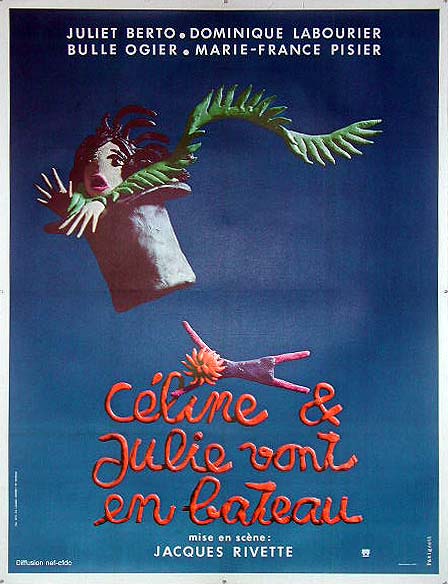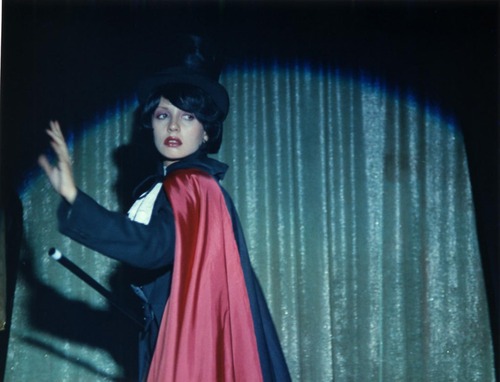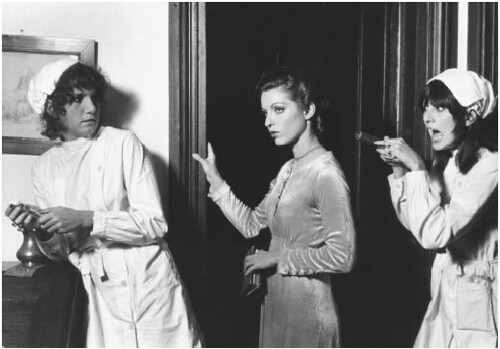Review: Céline et Julie vont en bateau
This delightful classic 1974 film, directed by Jacques Rivette, mischievously explores human relationships, friendship, magical connections, blurring of identities, force of habit and tricks of memory.
A title card appears on screen: ‘Most often, that’s how it started’. The setting is Paris—a summery, sunny Montmartre. Julie, a librarian, is sitting in a small square reading a book about spells. Céline, a stage magician, hurries by, dropping her sunglasses and then her scarf. Julie gives chase. So begin their adventures together.
Céline disguises herself as Julie, to meet and playfully deflate the pomposity of Julie’s childhood sweetheart. Meanwhile, Julie replaces Céline in her day job as nurse to Madlyn, an ailing young girl. It is Madlyn’s birthday, her first since the death of her mother, Nathalie, eight months previously. Before dying, Nathalie made her husband, Olivier, vow never to marry again while Madlyn was still alive. The two other members of this melodramatic household are a friend, Sophie, and Nathalie’s sister, Camille.
A dazed Julie whirls out of the old mansion and takes a large boiled lolly out of her mouth. She cannot remember what happened to her there, but as soon as she sucks on the lolly again, she begins to recall and narrate the day’s events to Céline. These events eerily tally with those Céline, as the nurse, experienced on previous days. The mansion is peopled by characters eternally reliving the same day.
Another day dawns. Now it’s Céline’s turn to play the nurse. So, Julie goes to the cabaret and performs, as a magician, replacing Céline. Then, that evening, when Céline sucks on the lollies, more pieces of the jigsaw begin to fall into place. It is clear young Madlyn is in mortal danger, but Céline and Julie still cannot tell who in the old house is going to murder the child.
The two of them brew a memory potion. Equipped with this, together, they go back to the mansion to rescue Madlyn. Swapping places, taking turns to be the nurse, by day’s end, with the aid of the potion, they discover the murderer’s identity. Then, they manage to flee with Madlyn. Later, they go boating.
The story comes full circle. Now, it is Céline sitting in the sunny square. Then, Julie races by, dropping her book of spells. Céline gives chase. A cat looks on. Céline and Julie, who were imagining and manipulating the ‘unreal’ people and events in the haunted mansion, are shown now, in their summery Parisian setting, to be imaginary and interchangeable, too—Phantom ladies over Paris, as Rivette subtitled the film.
The screenplay, by Rivette and the principal actors, is partly derived from a Henry James short story; it also has thematic references to Alice in Wonderland and Proust. There are nods to vaudeville, cabaret and slapstick. The Marx Brothers’ influence is also much in evidence. In one scene, Julie wears a Groucho mask; later, dressed in nurses’ uniforms, Céline and Julie mimic the ‘imaginary mirror’ scene from Duck Soup. The screenplay deftly intertwines realities and evokes relationships, while teasingly unravelling the mystery of the haunted house.
Sound is sparsely, but tellingly, used—children playing happily in the background, traffic noise, bird calls. Music, mainly piano, is important in the cabaret scenes. The songs add to the wistful aspect of the film.
The style is quirky and remarkably entertaining. Like a slow, meandering walk, the film is full of atmosphere and rewarding revelations. It is a mysterious and appealing story, with warmth and colour.
Image credits:1. Image credit Posterman
2. Image credit French Cinema Tumblr
3. Image credit Film Reference










Merci pour votre article. Je ne connais pas ce film et vous m’avez donné envie de redécouvrir Jacques Rivette ! J’avais beaucoup aimé “La belle noiseuse” de ce même réalisateur avec Emmanuelle Beart, l’excellent Michel Piccoli et Jane Birkin.
Au plaisir de lire votre prochain article.